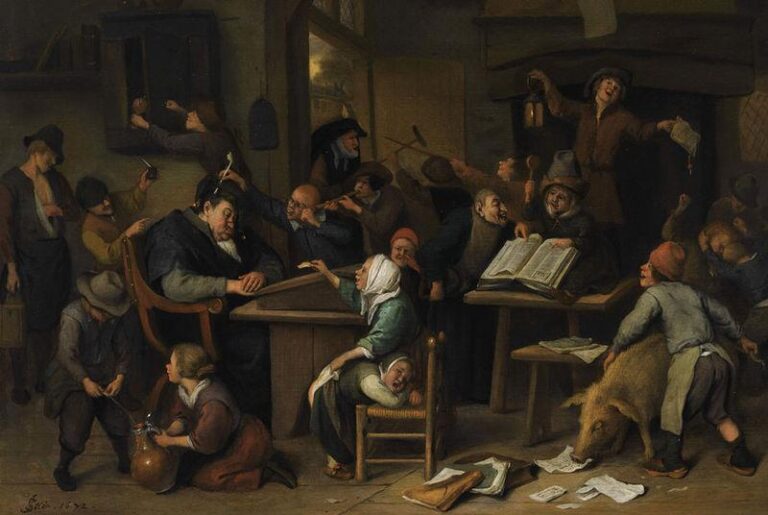An Old Master painting looted by the Nazis during World War II has recently surfaced in an online property listing in Argentina, raising fresh questions about the fate of countless artworks stolen during the conflict. The discovery, which came to light through investigative efforts, has prompted renewed calls for restitution and intensified scrutiny of the global art market’s role in handling disputed cultural property. Authorities and experts are now racing to verify the painting’s provenance and determine the next steps in what has become a high-profile case of art repatriation.
Old Master Painting Stolen During Nazi Era Surfaces in Argentine Real Estate Market
The resurfacing of a precious old master painting, believed to have been stolen during the Nazi era, has ignited a fresh wave of investigations in Argentina. The artwork, once lost to history, was recently discovered listed as part of a high-end real estate deal, drawing attention from both historians and art recovery experts. The painting, attributed to a renowned Baroque artist, had vanished amid the chaos of World War II, its trail cold for decades until this unexpected reappearance.
Key details surrounding the discovery include:
- The painting’s provenance is currently under rigorous verification by international authorities.
- Experts are analyzing the listing’s connection to known Nazi-looted art networks.
- Local authorities in Argentina have coordinated with global art restitution organizations to secure and preserve the piece.
| Aspect | Details |
|---|---|
| Artist | Baroque Master |
| Era Stolen | 1939-1945 |
| Location Found | Buenos Aires Property Listing |
| Current Status | Under Investigation |
Experts Examine Provenance to Confirm Wartime Looting and Ownership History
International experts have embarked on a meticulous investigation into the origins of the rediscovered old master painting, aiming to establish its wartime journey and rightful ownership. Utilizing archives from across Europe and Argentina, researchers are cross-referencing auction records, private sales, and wartime documentation to trace the artwork’s movement during the Nazi era. The process involves collaboration with museums, historical societies, and restitution organizations, all striving to unearth the painting’s provenance amidst decades of obscurity.
Key elements under review include:
- Ownership history prior to 1939
- Documentation of forced sales or confiscation
- Transfer and sale records in South America post-World War II
- Physical and stylistic analysis validating authenticity
| Year | Event | Source Location |
|---|---|---|
| 1938 | Confiscation by Nazi officials | Vienna |
| 1947 | Sale through private dealer | Buenos Aires |
| 2024 | Listing on Argentinian estate platform | Buenos Aires |
Calls for International Cooperation Intensify to Recover Cultural Property and Support Restitution Efforts
The recent discovery of a Nazi-looted Old Master painting listed for sale in Argentina has reignited urgent calls on the international stage to bolster efforts aimed at cultural property recovery. Governments, cultural institutions, and advocacy groups emphasize the necessity for enhanced cross-border collaboration, highlighting that such artworks represent irreplaceable historical and cultural heritage unjustly seized during turbulent times. Experts argue that only through unified legal frameworks and transparent provenance research can stolen artworks be identified and rightfully restituted to their legitimate owners.
Key recommendations put forward by restitution advocates include:
- Establishment of an international task force dedicated solely to tracking and recovering looted cultural assets.
- Mandatory disclosure of artwork provenance in auction houses and private sales worldwide.
- Strengthened legal cooperation between countries to expedite restitution claims.
- Investment in advanced databases compiling records of stolen art, accessible to law enforcement and art professionals.
| Entity | Role in Restitution | Current Status |
|---|---|---|
| UNESCO | Promotes cultural property protection treaties | Strengthening guidelines post-incident |
| Interpol | Operates stolen art databases | Increasing global member participation |
| National Governments | Enforce repatriation laws & bilateral agreements | Varies widely by country |
| National Governments | Enforce repatriation laws & bilateral agreements | Varies widely by country |
If you’d like, I can help you further refine or expand this content!
Concluding Remarks
The recent discovery of the Old Master painting on an Argentinian property listing has reignited calls for renewed efforts to locate and repatriate art looted during the Nazi era. As investigators and historians work to verify the provenance and ownership of the artwork, this case serves as a stark reminder of the enduring legacy of wartime theft and the ongoing quest for justice in the art world. Authorities and restitution groups are expected to intensify their collaboration in the coming months, seeking to ensure that stolen cultural treasures find their way back to their rightful homes.




